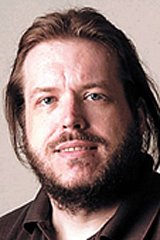Dark Matter
 (Image: courtesy of Chandra X-ray Observatory) Image of two colliding galaxy clusters showing x-ray and optical radiation. Hot gas detected by Chandra in x-ray part of the spectrum is seen as two central pink clumps in the image and contains most of the normal or baryonic matter in the two clusters. The optical image from Magellan and the Hubble Space Telescope shows the galaxies in orange and white. The blue parts in this image show areas where most of the mass in the clusters is found and are believed to be consisting of dark matter.
(Image: courtesy of Chandra X-ray Observatory) Image of two colliding galaxy clusters showing x-ray and optical radiation. Hot gas detected by Chandra in x-ray part of the spectrum is seen as two central pink clumps in the image and contains most of the normal or baryonic matter in the two clusters. The optical image from Magellan and the Hubble Space Telescope shows the galaxies in orange and white. The blue parts in this image show areas where most of the mass in the clusters is found and are believed to be consisting of dark matter. We can see ordinary matter or can feel its presence through the energy it emits in various parts of the electromagnetic spectrum, like radiowave, x-ray, microwave, gamma ray etc. Dark matter is exotic in the sense that it does not interact with any kind of electromagnetic wave and so can remain invisible to all kinds of telescopes that man have built. However, still we can feel its presence by some expected or weird movement of stars or galaxies around it because dark matter cannot escape the force of gravity. In fact, dark matter was originally hypothesized to explain the abnormally high rotation speeds of galaxies, which would otherwise be torn apart if they did not contain hidden mass. Astronomers estimate that dark matter and dark energy account for 80 to 90 percent of the matter in the universe. The more familiar kind of matter, which can be seen and felt, makes up the rest.
A solid evidence supporting the existence of this elusive matter has been absent for a long time. A group of US astromers led by Doug Clowe recently reported an exciting account of its presence by analyzing observational data from NASA's Chandra X-ray Observatory, the Hubble Space Telescope, the European Southern Observatory's Very Large Telescope and the Magellan optical telescopes for a violent collision between two large galaxy clusters 3 billion light years away. Their analysis is going to be published in forthcoming issues of Astrophysical Journal and Astrophysical Journal Letters.
Behind these observations lies a remarkable bullet-shaped cloud of hot gas produced by the collision of two clusters. As they cross at 10 million miles per hour, the luminous matter in each interacts with the other and slows down. But the dark matter does not interact at all, passing right through without disruption. This causes the dark matter to sail ahead, separating each cluster into two components: dark matter in the lead and luminous matter lagging behind.
To detect this se
 paration, researchers compared x-ray images of the luminous matter with measurements of the cluster's total mass through gravitational lensing. This involves the observation of the distortion of light from background galaxies by the cluster's gravity -- the greater the distortion, the more massive the cluster. The team discovered four separate clumps of matter (see the photo) : two large clumps of dark matter speeding away from the collision, and two smaller clumps of luminous matter trailing behind, proving two types of matter exist.
paration, researchers compared x-ray images of the luminous matter with measurements of the cluster's total mass through gravitational lensing. This involves the observation of the distortion of light from background galaxies by the cluster's gravity -- the greater the distortion, the more massive the cluster. The team discovered four separate clumps of matter (see the photo) : two large clumps of dark matter speeding away from the collision, and two smaller clumps of luminous matter trailing behind, proving two types of matter exist.Team members who accomplished this break-through research are: Doug Clowe and Dennis Zaritsky of Uuniversity of Arizona's Steward Observatory; Marusa Bradac of the Kavli Institute for Particle Astrophysics and Cosmology in Stanford, Calif.; Anthony Gonzalez of the University of Florida, and Maxim Markevitch, Scott Randall and Christine Jones of the Harvard-Smithsonian Center for Astrophysics.
photo of Doug Clowe (courtsey: University of Arizona)
Labels: Dark Matter

0 Comments:
Post a Comment